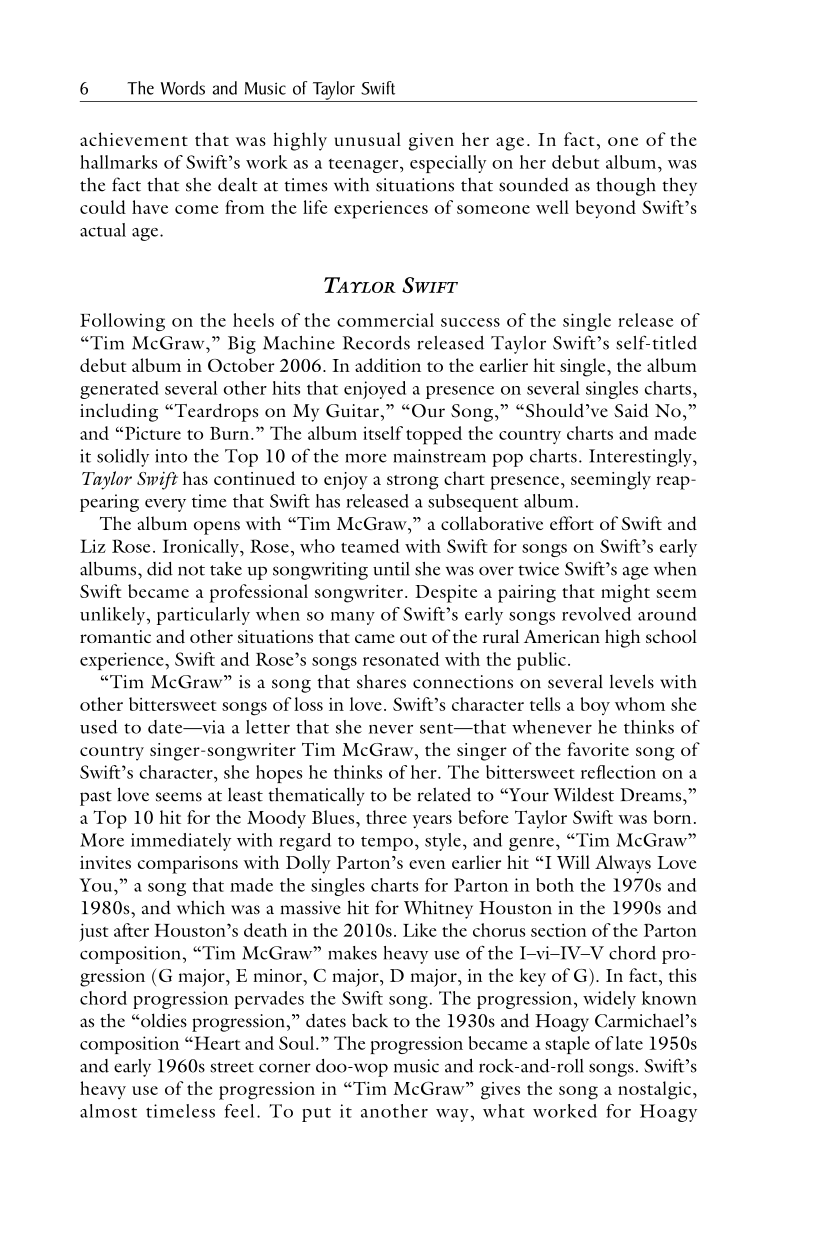achievement that was highly unusual given her age. In fact, one of the
hallmarks of Swift’s work as a teenager, especially on her debut album, was
the fact that she dealt at times with situations that sounded as though they
could have come from the life experiences of someone well beyond Swift’s
actual age.
TAYLOR SWIFT
Following on the heels of the commercial success of the single release of
“Tim McGraw,” Big Machine Records released Taylor Swift’s self-titled
debut album in October 2006. In addition to the earlier hit single, the album
generated several other hits that enjoyed a presence on several singles charts,
including “Teardrops on My Guitar,” “Our Song,” “Should’ve Said No,”
and “Picture to Burn.” The album itself topped the country charts and made
it solidly into the Top 10 of the more mainstream pop charts. Interestingly,
Taylor Swift has continued to enjoy a strong chart presence, seemingly reap-
pearing every time that Swift has released a subsequent album.
The album opens with “Tim McGraw,” a collaborative effort of Swift and
Liz Rose. Ironically, Rose, who teamed with Swift for songs on Swift’s early
albums, did not take up songwriting until she was over twice Swift’s age when
Swift became a professional songwriter. Despite a pairing that might seem
unlikely, particularly when so many of Swift’s early songs revolved around
romantic and other situations that came out of the rural American high school
experience, Swift and Rose’s songs resonated with the public.
“Tim McGraw” is a song that shares connections on several levels with
other bittersweet songs of loss in love. Swift’s character tells a boy whom she
used to date—via a letter that she never sent—that whenever he thinks of
country singer-songwriter Tim McGraw, the singer of the favorite song of
Swift’s character, she hopes he thinks of her. The bittersweet reflection on a
past love seems at least thematically to be related to “Your Wildest Dreams,”
a Top 10 hit for the Moody Blues, three years before Taylor Swift was born.
More immediately with regard to tempo, style, and genre, “Tim McGraw”
invites comparisons with Dolly Parton’s even earlier hit “I Will Always Love
You,” a song that made the singles charts for Parton in both the 1970s and
1980s, and which was a massive hit for Whitney Houston in the 1990s and
just after Houston’s death in the 2010s. Like the chorus section of the Parton
composition, “Tim McGraw” makes heavy use of the I–vi–IV–V chord pro-
gression (G major, E minor, C major, D major, in the key of G). In fact, this
chord progression pervades the Swift song. The progression, widely known
as the “oldies progression,” dates back to the 1930s and Hoagy Carmichael’s
composition “Heart and Soul.” The progression became a staple of late 1950s
and early 1960s street corner doo-wop music and rock-and-roll songs. Swift’s
heavy use of the progression in “Tim McGraw” gives the song a nostalgic,
almost timeless feel. To put it another way, what worked for Hoagy
6 The Words and Music of Taylor Swift









































































































































